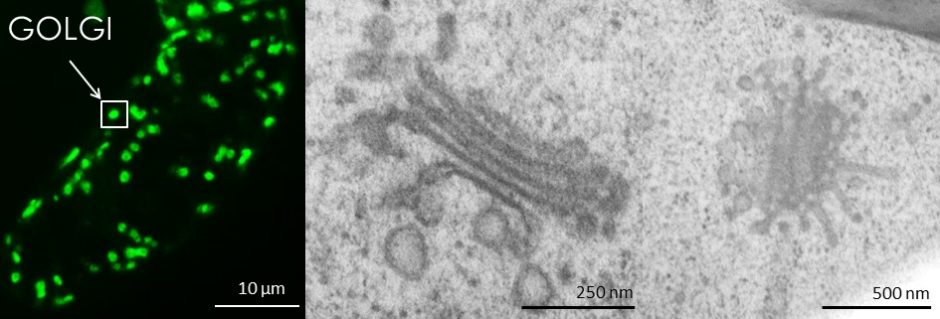
Article by: Miranda Meents (Lacey Samuels lab)
2015 is somewhat of an anniversary in cell biology. 350 years ago, Robert Hooke published the first description of what he called a cell. But it wasn’t until the mid-19th century that we started to look inside cells. Then, in 1898, the Italian scientist Camillo Golgi first described, and gave his name to, a cell structure that is the hero of this story, the Golgi Apparatus. We now know that the Golgi is a stack of flattened compartments like a stack of pita bread. Inside the pita pockets hundreds of chemical reactions occur as the Golgi makes, modifies and packages materials for the cell. Every animal, plant, and fungal cell has a Golgi. In plants, the Golgi is where many key components of the plant cell wall are produced. In humans, defects in Golgi structure or function have been associated with Alzheimer’s and Parkinson’s disease, as well as a growing list of less well-known disorders including neurological, skeletal, developmental, muscular, and more. But, despite close to 120 years of research, we still don’t really understand the basic mechanism behind Golgi function, and this is the question that my research is helping to address.
If we cut through the middle of the Golgi, in each pocket we would see a mix of what we call residents and cargo. The residents live in the Golgi; they are the workers that make and modify the cargo. The cargo is what is being modified and packaged before it leaves the Golgi to move somewhere else in the cell. It might help to think of the Golgi as a can of mixed nuts. Some of the nuts are like Golgi cargo, say pecans, and we need to quickly pull them out so they can get to where they need to go. Other nuts are like residents, cashews for example. To carry out their function they have to stay in the mix. But how do we quickly and efficiently remove the pecans while leaving the cashews behind? This question has been extremely difficult to answer because the Golgi is very small, very active, and very efficient. The system I am using, however, allows me to work around these problems and determine how the Golgi functions.
I am mapping the location of residents and cargo within the Golgi. To do this, I have created fluorescently tagged residents that allow me to label the Golgi in plant cells. I can then find these residents and their cargo within the Golgi in high resolution images taken with an electron microscope. I can then compare the location of the residents and cargo and use the information to build a hypothesis about how the Golgi is able to sort through all of its contents, as well as it does. Ultimately, this research could influence an astonishing breadth of disciplines, from medicine to biofuels to beer, simply because the Golgi is such a key player in how all types of organisms function.






